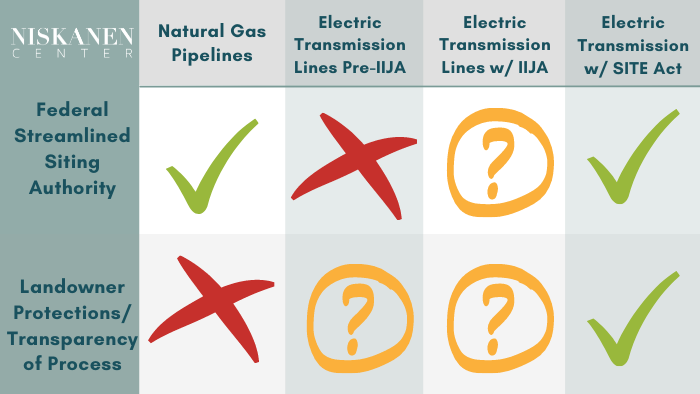
Expanding and updating America’s electric transmission system is critical to powering the 21st-century economy. The difficulty of planning and siting interstate transmission is the single largest issue facing the development of today’s otherwise economically viable generation projects.
Recent court cases opposing natural gas projects have led some to wonder why natural gas isn’t sited like transmission, erroneously concluding that the lack of transmission court cases means transmission siting is straightforward. Transmission siting is so convoluted that lines never make it to court because they never have the opportunity to even get started (see this report of 22 projects, many that are more than ten years in development).
FERC has a relatively streamlined siting process for natural gas projects that provides pipeline companies a significant advantage in getting pipes in the ground compared to transmission companies. If FERC finds a project to be in the public interest (a process that should be more transparent and rigorous than it is), it confers extraordinary powers to pipeline companies. Among them is the ability to exercise federal eminent domain authority to take private land from unwilling sellers—including states.
Increased capacity for electricity transmission is also clearly in the public interest, so there are valuable parallels and avenues for potential FERC analysis and authorization. However, FERC’s backstop siting authority was only recently re-established in the Infrastructure Innovation and Jobs Act (IIJA), and there are still many considerations at play. Of primary concern is how DOE and FERC rulemaking will be exercised to help transmission projects get off the ground and avoid the significant issues in the piecemeal state siting approach that has been required up until this point.
Transporting electricity over long distances is the most critical and cost-effective mechanism to decarbonize our electricity sector and modernize the grid. Following the House FERC oversight hearing this summer, FERC Chairman Glick responded for the record that he “will defer to Congress to assess whether the Commission should have siting authority for electric transmission similar to its authority over interstate natural gas pipelines.” In the IIJA, Congress re-opened the door to federal authority for siting transmission lines—an essential component of any legitimate decarbonization plan. Implementing the IIJA may require rulemaking at both DOE and FERC, meaning there’s still much uncertainty around defining the parameters of siting authority and the eminent domain process.
There is now an opportunity for transmission siting to adopt the efficiency of natural gas siting, while avoiding its worst—and arguably unlawful— aspects. The SITE Act is a good model for this, providing notice, transparency of process, and clear timelines for the siting and eminent domain processes. Some of these elements can, and should, be adopted by FERC via the IIJA without additional legislation. Yet to date, FERC has taken no such action. As Chairman Glick implied, Congress therefore must also step up to help ensure the Commission prioritizes and rectifies these issues.
Featured image: iStock